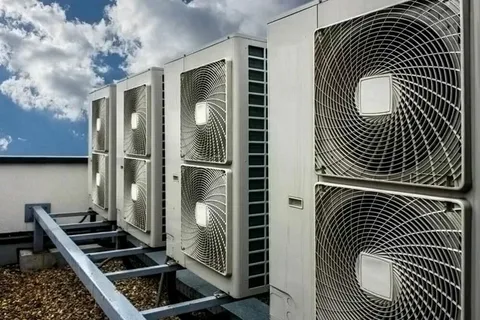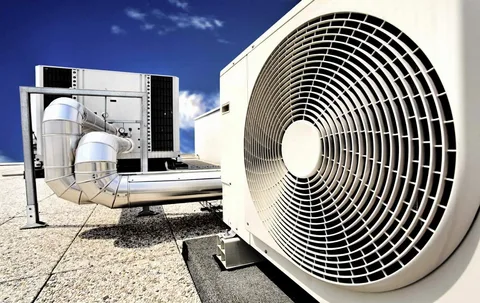A reliable heating and ventilation unit is essential for creating a comfortable and healthy living environment. It helps regulate your home’s temperature, humidity, and air quality, ensuring that you and your family are comfortable all year round. In this guide, we will explore the different types of heating & ventilation units, how to select the right heating & ventilation companies, the importance of proper ventilation in your home, maintenance tips, joint issues and troubleshooting, and the significance of an exhaust ventilation-system.
Different Types Of Heating & Ventilation Units
The market offers a diverse range of heating & ventilation units, catering to varying needs and preferences. Central heating and air conditioning systems are widely favoured for their ability to provide uniform temperature control throughout a property. Heat pumps stand out for their efficiency, particularly in mild climates, because they transfer heat rather than generate it directly. Ductless mini-split systems offer a flexible solution for heating and cooling individual rooms without extensive ductwork, making them ideal for renovations or extensions.
Radiant floor heating provides an even, comfortable warmth underfoot, perfect for those seeking a cosy atmosphere during colder months. Portable heaters and fans can address immediate heating or cooling needs in specific areas, offering a convenient, albeit temporary, solution. Each type of unit has its distinct advantages, and the selection should be based on the space’s particular requirements, personal preferences, and energy efficiency considerations.
 Selecting the Right Heating and Ventilation Companies
Selecting the Right Heating and Ventilation Companies
Selecting the proper heating and ventilation companies is a decision that should be taken seriously, as it directly impacts your heating & ventilation system’s effectiveness, efficiency, and longevity. Conduct thorough research into local companies, focusing on their credentials, experience, and customer reviews. A reputable company should have a solid record of successful installations and satisfied customers.
In addition to checking qualifications, consider the range of services offered. The ideal heating & ventilation company should provide a comprehensive suite of services, including consultation, installation, maintenance, and repair, ensuring a one-stop solution for all your heating & ventilation needs. Furthermore, it’s wise to assess their expertise in the specific type of system you are interested in, whether central heating, ductless mini-splits, or heat pumps.
Customer service is another crucial factor. The responsiveness and professionalism of a company when handling enquiries and providing support can indicate their overall approach to customer satisfaction. Engage with potential companies directly, asking detailed questions about their services, warranty offerings, and support post-installation. This interaction will also give you a sense of their expertise and willingness to tailor their services to your requirements.
The Importance of Proper Ventilation in Your Home
Maintaining high-quality indoor air is imperative for household occupants’ health and comfort, underscoring the critical role of adequate ventilation. A well-designed ventilation system ensures a continuous exchange of indoor air with fresh outdoor air, mitigating the accumulation of pollutants, dampness, and unpleasant odours. Such pollutants may include:
- Volatile organic compounds (VOCs) from paints and furnishings.
- Carbon monoxide from combustion appliances.
- Particulate matter from cooking and outdoor pollution.
Adequate ventilation also plays a pivotal role in controlling humidity levels within the home, which, if left unchecked, could foster the growth of mould and dust mites. These allergens can significantly impact the respiratory health of residents, particularly those with asthma or allergies. Furthermore, in the cooler months, ventilation aids in the distribution of heated air, enhancing the overall efficiency of the heating system by reducing the likelihood of cold spots and stagnant air.
By incorporating strategies such as natural ventilation, which utilises windows and vents, alongside mechanical systems like extractor fans and heat recovery ventilators, households can achieve a balanced and healthful indoor atmosphere. This approach supports the well-being of occupants and contributes to preserving the building’s structure by preventing moisture damage.
Understanding Heating and Ventilation
Heating & ventilation systems ensure a comfortable and healthful atmosphere within our homes. They operate by regulating the indoor climate—this encompasses the temperature and the quality of the air we breathe. A well-functioning heating and ventilation system can efficiently warm or cool our spaces, depending on the season, while removing stale air and introducing fresh air from outside.
This dual function is crucial for preventing the build-up of humidity, which can lead to mould and mildew, and for eliminating indoor pollutants that can adversely affect our health. Understanding how these systems work together to achieve this balance is critical to appreciating their importance in our daily lives. It is not merely about heating or cooling our environments but about creating a safe, comfortable, and healthy living space by effectively managing airflow and temperature.
Maintenance Tips for Your Heating & Ventilation Unit
Ensuring the optimal performance of your heating & ventilation unit requires regular upkeep. Here are several maintenance tips to consider:
Regularly clean or replace filters
This is one of the simplest yet most effective ways to keep your system running smoothly. A clean filter allows for better airflow and efficiency and prevents dust and debris from entering the unit. Depending on the type of filter and usage, this should be done every one to three months.
Inspect ducts and vents
Keep an eye on the ductwork for any signs of leaks or blockages. Leaks can significantly decrease the system’s efficiency by allowing heated or cooled air to escape before reaching its intended destination within your home. Similarly, make sure furniture and precise forms do not obstruct vents to ensure proper air circulation.
Schedule professional servicing
Even with diligent personal maintenance, a professional check-up is advisable at least once a year. Technicians can perform a more thorough inspection and cleaning and identify and fix any potential issues before they escalate into costly repairs.
Be mindful of unusual noises or odours
Any sudden changes in how your unit sounds or smells could indicate a problem. Odd noises may suggest a loose part, while unusual smells could be symptomatic of mould or mildew within the system. Promptly addressing these signs can prevent minor issues from developing into significant concerns.
The Process of Ventilation Installation
The process of Ventilation installation is a critical step towards enhancing any living space’s air quality and comfort. Initially, a thorough evaluation of the property is conducted to determine the most effective ventilation strategy, considering factors such as room sizes, layout, and the specific needs of the inhabitants. Following this assessment, a plan is meticulously crafted, outlining the optimal placement of vents and ductwork to ensure efficient air circulation.
The installation process itself involves the careful integration of these components into the building’s structure, which may require modifications to walls or ceilings to accommodate the new system. It’s vital to adhere to building codes and standards throughout the installation to ensure safety and compliance. Professional installers will also ensure that the system is seamlessly connected to any existing heating and cooling systems, enabling a holistic approach to climate control within the property.
Once installed, a comprehensive test of the ventilation system is performed to confirm its operational efficiency and effectiveness in maintaining optimal indoor air quality. This proactive approach ensures that the newly installed ventilation system contributes significantly to a healthier and more comfortable indoor environment.
Common Issues and Troubleshooting
Heating & ventilation systems, whilst designed to be robust, can sometimes encounter operational hiccups that require attention. One frequent issue is the presence of air leaks in ductwork, which can significantly diminish the system’s efficiency. Identifying and sealing these leaks is crucial for restoring optimal performance. Faulty thermostats are another common culprit that can disrupt the regulation of home temperatures.
If your thermostat is not responding or displaying incorrect readings, it might need recalibration or replacement. Clogged filters, a recurrent problem, restrict airflow and strain the system, leading to inefficiency and potential damage. Regular inspection and cleaning or replacing filters can avert this issue. Due to wear and tear, components within the unit may become worn out over time.
Recognising and addressing unusual noises or declining system performance early can prevent these issues from escalating into significant faults. For any troubleshooting beyond essential maintenance, enlisting the expertise of a professional technician is advisable. They can conduct a comprehensive assessment and undertake necessary repairs, ensuring your heating & ventilation system remains in peak condition.
The Significance of an Exhaust Ventilation System
An exhaust ventilation-system is critical in maintaining a healthy and comfortable indoor environment, particularly in spaces where moisture, odours, or pollutants can compromise air quality. Its primary function is to remove stale air from within a building and expel it outdoors, thereby preventing the build-up of contaminants that could adversely affect the health of occupants.
This is especially relevant in areas like kitchens and bathrooms, where humidity levels tend to be higher and in basements or industrial spaces where chemicals or other hazardous materials may be present. Introducing an exhaust ventilation system can significantly enhance the overall effectiveness of a building’s heating & ventilation strategy by ensuring that fresh, clean air is continuously circulated.
It complements the heating & ventilation unit by explicitly targeting and removing air that could carry pollutants or excess moisture, which, if left unchecked, could lead to the growth of mould and mildew, damaging the building’s structure and potentially harming residents’ health. Moreover, by efficiently managing air removal, exhaust ventilation-systems can also assist in regulating the indoor temperature and reducing the need for air conditioning during warmer months, leading to energy savings.
FAQs
Q: How frequently should one change the filters in a heating & ventilation unit?
A: The filters should be swapped out every one to three months, depending on how often the unit is operated and the specific filter employed.
Q: Is it feasible for me to install a heating & ventilation unit on my own?
A: Although certain models are marketed for DIY installation, it is highly recommended that you enlist the services of a proficient technician to ensure the installation is conducted correctly and to mitigate any potential safety risks.
Q: What’s the expected service life of a heating and ventilation unit?
A: Typically, a heating and ventilation unit can be anticipated to serve effectively for about 10 to 15 years. This estimate can vary based on the unit’s frequency of use and the rigour of its maintenance schedule.
Q: Should the exterior components of the unit also be checked regularly?
A: Yes, it’s imperative to regularly inspect the unit’s external parts for debris or obstructions that could hamper its operational efficiency. This is essential maintenance to ensure the system’s longevity and proper functioning.
Q: Can regular maintenance impact the efficiency of my unit?
A: Adhering to a scheduled maintenance routine, including timely filter changes and ductwork inspections, can significantly enhance the efficiency of your heating & ventilation unit, potentially lowering energy costs.
Conclusion
In conclusion, choosing and maintaining a heating & ventilation unit are pivotal in ensuring a comfortable and healthy living environment. By understanding the various types available, selecting reputable companies for installation and service, and adhering to regular maintenance practices, homeowners can enhance the longevity and efficiency of their systems. Proper ventilation, through both natural and mechanical means, remains crucial in maintaining indoor air quality. Addressing common issues promptly and appreciating the role of an exhaust ventilation-system further contribute to a harmonious home atmosphere.
| Other Good Articles to Read |
| skank blogs |
| unreal blogs |
| tba blogs |
| all city forums |
| dany blogs |
| refuge blogs |
| the music blogs |
| key forums |
| the big blog theory |
| joe blogs |
| blogs 4 me |
| Blogs Emon |
| Related Business Listings |
| Contact Directory |
| Local Business Profiles |

